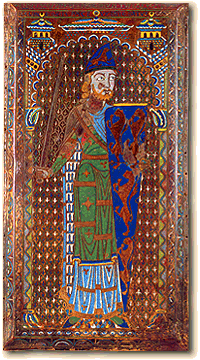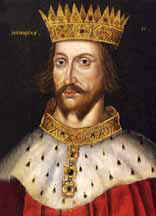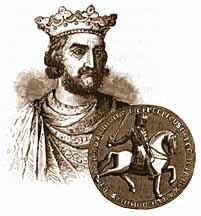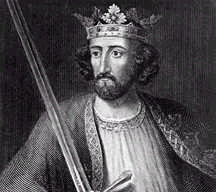| My
Plantagenet ancestors |
| GENERATION
#01 |
|
Geoffrey Plantagenet

Geoffrey Plantagenet [1]

 son of Fulk of Anjou, King of Jerusalem and
Ermengarde of Maine, was the first to assume the name Plantagenet.
He was born on August 24, 1113. His companions dubbed him "Plantagenet" because of the broom
corn he wore on his person. King Henry I, in
1127, when a new alliance was made at Rouen,
betrothed his daughter Maud, or
Matilda, to
Geoffrey, and the marriage was celebrated at Le Mans, France, June 2,
1127. She was called the Empress Maud, being the
widow of Henry V, Emperor of the Roman Empire and later of Germany,
whom she had married Jan. 7, 1114. From the first Geoffrey
tried to profit by his marriage, and after the death
of Henry I, Dec. 1, 1135, laid the foundation for the conquest of
Normandy, by a series of campaigns; about the end of
1135 or beginning of 1136 he entered that country and rejoined
his wife, the Countess Maud. After many battles he received the submission
of Argentan, Domfront, Bayeux, Caen and Falaise. In
March, 1141, on hearing of his wife's success in England he
entered Normandy, and many towns surrendered, and in 1144 he entered Rouen
and received the ducal crown of Normandy in its
cathedral. Finally in 1149, after crushing a last attempt at revolt,
he handed over the Duchy to his son Henry, who received the investiture at
tfhe hands of the King of France. Geoffrey
Plantagenet had, by Maud, who died Sept. 10, 1167, a son and successor
Henry, Count of Anjou, who ascended the throne of England as Henry II. (He
also had a natural son, Hameline Plantagenet, who
married Isabel de Warren, and took the name of d Warren, and became
through his wife the Earl of Warren and Surrey. Geoffrey
Plantagenet, a prince of great justice and charity, died Sept., 1150,
and was buried at Mans, in St. Julien's Church.
son of Fulk of Anjou, King of Jerusalem and
Ermengarde of Maine, was the first to assume the name Plantagenet.
He was born on August 24, 1113. His companions dubbed him "Plantagenet" because of the broom
corn he wore on his person. King Henry I, in
1127, when a new alliance was made at Rouen,
betrothed his daughter Maud, or
Matilda, to
Geoffrey, and the marriage was celebrated at Le Mans, France, June 2,
1127. She was called the Empress Maud, being the
widow of Henry V, Emperor of the Roman Empire and later of Germany,
whom she had married Jan. 7, 1114. From the first Geoffrey
tried to profit by his marriage, and after the death
of Henry I, Dec. 1, 1135, laid the foundation for the conquest of
Normandy, by a series of campaigns; about the end of
1135 or beginning of 1136 he entered that country and rejoined
his wife, the Countess Maud. After many battles he received the submission
of Argentan, Domfront, Bayeux, Caen and Falaise. In
March, 1141, on hearing of his wife's success in England he
entered Normandy, and many towns surrendered, and in 1144 he entered Rouen
and received the ducal crown of Normandy in its
cathedral. Finally in 1149, after crushing a last attempt at revolt,
he handed over the Duchy to his son Henry, who received the investiture at
tfhe hands of the King of France. Geoffrey
Plantagenet had, by Maud, who died Sept. 10, 1167, a son and successor
Henry, Count of Anjou, who ascended the throne of England as Henry II. (He
also had a natural son, Hameline Plantagenet, who
married Isabel de Warren, and took the name of d Warren, and became
through his wife the Earl of Warren and Surrey. Geoffrey
Plantagenet, a prince of great justice and charity, died Sept., 1150,
and was buried at Mans, in St. Julien's Church.
|
|
GENERATION
#02 |
|
King Henry II Plantagenet of England

King Henry II Plantagenet, King of England
[1]

 (1133-89), first monarch of the house of Anjou, or Plantagenet, an important administrative reformer, who was one of the most powerful European rulers of his time.
Born March 5, 1133, at Le Mans, France, Henry became duke of Normandy in 1151. The following year, on the death of his father, he inherited the Angevin territories in France. By his marriage in 1152 to
Eleanor of Aquitaine, Henry added vast territories in southwestern France to his possessions. Henry claimed the English kingship through his mother, Matilda. She had been designated the heiress of Henry I but had been deprived of the succession by her cousin, Stephen of Blois, who made himself king. In 1153 Henry defeated Stephen's armies in England and compelled the king to choose him as his successor; on Stephen's death, the following year, Henry became king. During the first few years of his reign Henry quelled the disorders that had developed during Stephen's reign, regained the northern counties of England, which had previously been ceded to Scotland, and conquered North Wales. In 1171-72 he began the Norman conquest of Ireland and in 1174 forced William the Lion, king of the Scots, to recognize him as overlord.
(1133-89), first monarch of the house of Anjou, or Plantagenet, an important administrative reformer, who was one of the most powerful European rulers of his time.
Born March 5, 1133, at Le Mans, France, Henry became duke of Normandy in 1151. The following year, on the death of his father, he inherited the Angevin territories in France. By his marriage in 1152 to
Eleanor of Aquitaine, Henry added vast territories in southwestern France to his possessions. Henry claimed the English kingship through his mother, Matilda. She had been designated the heiress of Henry I but had been deprived of the succession by her cousin, Stephen of Blois, who made himself king. In 1153 Henry defeated Stephen's armies in England and compelled the king to choose him as his successor; on Stephen's death, the following year, Henry became king. During the first few years of his reign Henry quelled the disorders that had developed during Stephen's reign, regained the northern counties of England, which had previously been ceded to Scotland, and conquered North Wales. In 1171-72 he began the Norman conquest of Ireland and in 1174 forced William the Lion, king of the Scots, to recognize him as overlord.
In 1164 Henry became involved in a quarrel with Thomas à Becket, whom he had appointed archbishop of Canterbury. By the Constitutions of Clarendon, the king decreed that priests accused of crimes should be tried in royal courts; Becket claimed that such cases should be handled by ecclesiastical courts, and the controversy that followed ended in 1170 with Becket's murder by four of Henry's knights. Widespread indignation over the murder forced the king to rescind his decree and recognize Becket as a martyr.
Although he failed to subject the church to his courts, Henry's judicial reforms were of lasting significance. In England he established a centralized system of justice accessible to all freemen and administered by judges who traveled around the country at regular intervals. He also began the process of replacing the old trial by ordeal with modern court procedures.
From the beginning of his reign, Henry was involved in conflict with Louis VII, king of France, and later with Louis's successor, Philip II, over the French provinces that Henry claimed. A succession of rebellions against Henry, headed by his sons and furthered by Philip II and by Eleanor of Aquitaine, began in 1173 and continued until his death at Chinon, France, on July 6, 1189. Henry was succeeded by his son Richard I, called Richard the Lion-Hearted. |
|
GENERATION
#03 |
|
King John "Lackland" of England

King John "Lackland" of England
[1]

 (1167-1216), best known for signing the Magna Carta.
John was born in Oxford on December 24, 1167, the youngest son of King Henry II and Eleanor of Aquitaine.
He married Isabella Taillefer on August 26
1200 in Bordeaux, Gironde, France. Henry provided for the eventual inheritance of his lands by his older sons before John was born. By 1186, however, only Richard I, the Lion-Hearted, and John were left as Henry's heirs. In 1189, as Henry neared death, John joined Richard's rebellion against their father, and when Richard was crowned, he gave John many estates and titles. John tried but failed to usurp the Crown while Richard was away on the Third Crusade: Upon returning to England, Richard forgave him. When his brother died in 1199, John became king. A revolt ensued by the supporters of Arthur of Brittany, the son of John's brother, Geoffrey. Arthur was defeated and captured in 1202, and John is believed to have had him murdered. King Philip II of France continued Arthur's war until John had to surrender nearly all his French possessions in 1204. In 1207 John refused to accept the election of Stephen Langton as archbishop of Canterbury. Pope Innocent III then excommunicated him and began negotiating with Philip for an invasion of England. Desperate, John surrendered England to the pope and in 1213 received it back as a fief. Trying to regain his French possession, he was decisively defeated by Philip in 1214. John's reign had become increasingly tyrannical; to support his wars he had extorted money, raised taxes, and confiscated properties. His barons finally united to force him to respect their rights and privileges. John had little choice but to sign the Magna Carta presented to him by his barons at Runnymede in 1215, making him subject, rather than superior, to the law. Shortly afterward John and the barons were at war. He died at Newark in Nottinghamshire on October 19, 1216, while still pursuing the campaign, and was succeeded by his son, Henry III.
(1167-1216), best known for signing the Magna Carta.
John was born in Oxford on December 24, 1167, the youngest son of King Henry II and Eleanor of Aquitaine.
He married Isabella Taillefer on August 26
1200 in Bordeaux, Gironde, France. Henry provided for the eventual inheritance of his lands by his older sons before John was born. By 1186, however, only Richard I, the Lion-Hearted, and John were left as Henry's heirs. In 1189, as Henry neared death, John joined Richard's rebellion against their father, and when Richard was crowned, he gave John many estates and titles. John tried but failed to usurp the Crown while Richard was away on the Third Crusade: Upon returning to England, Richard forgave him. When his brother died in 1199, John became king. A revolt ensued by the supporters of Arthur of Brittany, the son of John's brother, Geoffrey. Arthur was defeated and captured in 1202, and John is believed to have had him murdered. King Philip II of France continued Arthur's war until John had to surrender nearly all his French possessions in 1204. In 1207 John refused to accept the election of Stephen Langton as archbishop of Canterbury. Pope Innocent III then excommunicated him and began negotiating with Philip for an invasion of England. Desperate, John surrendered England to the pope and in 1213 received it back as a fief. Trying to regain his French possession, he was decisively defeated by Philip in 1214. John's reign had become increasingly tyrannical; to support his wars he had extorted money, raised taxes, and confiscated properties. His barons finally united to force him to respect their rights and privileges. John had little choice but to sign the Magna Carta presented to him by his barons at Runnymede in 1215, making him subject, rather than superior, to the law. Shortly afterward John and the barons were at war. He died at Newark in Nottinghamshire on October 19, 1216, while still pursuing the campaign, and was succeeded by his son, Henry III. |
|
GENERATION
# 04 |
|
King Henry III of England

King Henry III (of England)
[1]

 (1207-72), king of
England (1216-72), son and successor of King John (Lackland), and a member
of the house of Anjou, or Plantagenet. Henry ascended the throne at the
age of nine, on the death of his father. During his minority the kingdom
was ruled by William Marshal, earl of Pembroke, as regent, but after his
death in 1219 the justiciar Hubert de Burgh was the chief power in the
government. During the regency the French, who occupied much of eastern
England, were expelled, and rebellious barons were subdued.sources.htm#HenryPlantagenet1207
(1207-72), king of
England (1216-72), son and successor of King John (Lackland), and a member
of the house of Anjou, or Plantagenet. Henry ascended the throne at the
age of nine, on the death of his father. During his minority the kingdom
was ruled by William Marshal, earl of Pembroke, as regent, but after his
death in 1219 the justiciar Hubert de Burgh was the chief power in the
government. During the regency the French, who occupied much of eastern
England, were expelled, and rebellious barons were subdued.sources.htm#HenryPlantagenet1207
Henry was declared of age in 1227. In 1232
he dismissed Hubert de Burgh from his court and commenced ruling without
the aid of ministers. Henry displeased the barons by filling government
and church offices with foreign favorites, many of them relatives of his
wife,
Eleanor of Provence, whom he married in
1236, and by squandering money on Continental wars, especially in France.
In order to secure the throne of Sicily for one of his sons, Henry agreed
to pay the pope a large sum. When the king requested money from the barons
to pay his debt, they refused and in 1258 forced him to agree to the
Provisions of Oxford, whereby he agreed to share his power with a council
of barons. Henry soon repudiated his oath, however, with papal approval.
After a brief period of war, the matter was referred to the arbitration of
Louis IX, king of France, who decided in Henry's favor in a judgment
called the Mise of Amiens (1264). Simon de Montfort, earl of Leicester,
accordingly led the barons into war, defeated Henry at Lewes, and took him
prisoner. In 1265, however, Henry's son and heir, Edward, later King
Edward I, led the royal troops to victory over the barons at Evesham,
about 40.2 km (about 25 mi) south of Birmingham. Simon de Montfort was
killed in the battle, and the barons agreed to a compromise with Edward
and his party in 1267. From that time on Edward ruled England, and when
Henry died, he succeeded him as king.
I descend through 2 children of Henry and Eleanor: King Edward
(see generation #5 below), and Edmund Plantagenet, born Jan. 16, 1245 who
married Blanche D'Artois. Edmond's line is:
1. Edmund Plantagenet
 [1]
(1245-1296) [1]
(1245-1296)
Married
Blanche D'Artois (c1245-1300)
1.
Henry Plantagenet
 [1]
(c1281-1345) -
[1]
(c1281-1345) -
Married
Maud De Chaworth (c1282-1322)
1. Eleanor Plantagenet
 [1]
(c1318-1372) -
[1]
(c1318-1372) -
Married
Richard FitzAlan (c1306-1376)
- see FitzAlan surname
for continuation of this line
2. Joan Plantagenet (-1349)
Married Sir John De Mowbray (-1361) - Mowbray surname will have
continuation of this line |
| GENERATION
# 05 |
|
King Edward I of England

Edward I, called "Longshanks"
[1]

 (1239-1307),
king of England (1272-1307), of the house of Plantagenet. He was born in
Westminster on June 17, 1239, the eldest son of King Henry III, and at 15
married
Eleanor of Castile. In the struggles
of the barons against the crown for constitutional and ecclesiastical
reforms, Edward took a vacillating course. When warfare broke out between
the crown and the nobility, Edward fought on the side of the king, winning
the decisive battle of Evesham in 1265. Five years later he left England
to join the Seventh Crusade. Following his father's death in 1272, and
while he was still abroad, Edward was recognized as king by the English
barons; in 1273, on his return to England, he was crowned.
(1239-1307),
king of England (1272-1307), of the house of Plantagenet. He was born in
Westminster on June 17, 1239, the eldest son of King Henry III, and at 15
married
Eleanor of Castile. In the struggles
of the barons against the crown for constitutional and ecclesiastical
reforms, Edward took a vacillating course. When warfare broke out between
the crown and the nobility, Edward fought on the side of the king, winning
the decisive battle of Evesham in 1265. Five years later he left England
to join the Seventh Crusade. Following his father's death in 1272, and
while he was still abroad, Edward was recognized as king by the English
barons; in 1273, on his return to England, he was crowned.
The first years of Edward's reign were a
period of the consolidation of his power. He suppressed corruption in the
administration of justice, restricted the jurisdiction of the
ecclesiastical courts to church affairs, and eliminated the papacy's
overlordship over England.
On the refusal of Llewelyn ab Gruffydd,
ruler of Wales, to submit to the English crown, Edward began the military
conflict that resulted, in 1284, in the annexation of Llewelyn's
principality to the English crown. In 1290 Edward expelled all Jews from
England. War between England and France broke out in 1293 as a result of
the efforts of France to curb Edward's power in Gascony. Edward lost
Gascony in 1293 and did not again come into possession of the duchy until
1303. About the same year in which he lost Gascony, the Welsh rose in
rebellion.
Greater than either of these problems was
the disaffection of the people of Scotland. In agreeing to arbitrate among
the claimants to the Scottish throne, Edward, in 1291, had exacted as a
prior condition the recognition by all concerned of his overlordship of
Scotland. The Scots later repudiated him and made an alliance with France
against England. To meet the critical situations in Wales and Scotland,
Edward summoned a parliament, called the Model Parliament by historians
because it was a representative body and in that respect was the
forerunner of all future parliaments. Assured by Parliament of support at
home, Edward took the field and suppressed the Welsh insurrection. In
1296, after invading and conquering Scotland, he declared himself king of
that realm. In 1298 he again invaded Scotland to suppress the revolt led
by Sir William Wallace. In winning the Battle of Falkirk in 1298, Edward
achieved the greatest military triumph of his career, but he failed to
crush Scottish opposition.
The conquest of Scotland became the ruling
passion of his life. He was, however, compelled by the nobles, clergy, and
commons to desist in his attempts to raise by arbitrary taxes the funds he
needed for campaigns. In 1299 Edward made peace with France and married
Margaret, sister of King Philip III of France. Thus freed of war, he again
undertook the conquest of Scotland in 1303. Wallace was captured and
executed in 1305. No sooner had Edward established his government in
Scotland, however, than a new revolt broke out and culminated in the
coronation of Robert Bruce as king of Scotland. In 1307 Edward set out for
the third time to subdue the Scots, but he died en route near Carlisle on
July 7, 1307. |
| GENERATION
# 06a |
Princess Joan Plantagenet, of Acre Joan of Acre
[1]

 daughter of King Edward I and
Eleanor was born in 1282 in Acre, Palestine. She married
Gilbert
De Clare on April 30, 1290 in Westminster. She was a remarkably
active woman in the dozen years following the Red Earl's death. By
the terms of the marriage agreement of 1290, the entire inheritance
was enfeoffed jointly on Gilbert and Joan. This meant that it would not be
possible for her father Edward I to grant her only a third of the
estates and control the rest himself during the long minority of her
son Gilbert. Joan was thus sole mistress of the inheritance, and she
controlled it with marked ability. In 1297, much to Edward's
displeasure, she secretly married an otherwise obscure knight in her
'familia', Ralph de Monthermer (d. 1325).
daughter of King Edward I and
Eleanor was born in 1282 in Acre, Palestine. She married
Gilbert
De Clare on April 30, 1290 in Westminster. She was a remarkably
active woman in the dozen years following the Red Earl's death. By
the terms of the marriage agreement of 1290, the entire inheritance
was enfeoffed jointly on Gilbert and Joan. This meant that it would not be
possible for her father Edward I to grant her only a third of the
estates and control the rest himself during the long minority of her
son Gilbert. Joan was thus sole mistress of the inheritance, and she
controlled it with marked ability. In 1297, much to Edward's
displeasure, she secretly married an otherwise obscure knight in her
'familia', Ralph de Monthermer (d. 1325). Joan of Acre died in April, 1307, but during her
tenure of the inheritance important modifications were introduced in
its administrative structure. After Isabella de Fortibus, dowager countess
of Devon and Aumale (1262-93), Countess Joan stands as perhaps the
best example in thirteenth century English history of the ability of a
widow to run the estates and otherwisemanage the complex affairs of a
great comital house. The marriage between Gilbert and Joan had
long been planned and long delayed. Joan was Edward's second surviving
daughter, born when her father was still on crusade in 1272. In 1276
Rudolf of Hapsburg, the German Emperor, had prosed a marriage between the
girl and his son Hartmann. Negotiations were conducted in 1277 and 1278,
but the whole project had to be abandoned when Hartmann was accidentally
killed in December, 1281. In May, 1283, The king agreed to a marrige
between his daughter and Earl Gilbert The Earl had been separated
from Alice de Lusignan since 1271, but a formal annulment was now
required, and the marriage was finally dissolved in May, 1285. The king
and the earl still had to wait for a papal dispensation for the new
marriage, and it was only forthcoming in November, 1289. Source: Michael Altschul, "A Baronial
Family in Medieval England: The Clares,1217-1314" (1965)
I descend from Joan and Gilbert's daughter Margaret
DeClare who married Hugh D'Audley. |
| GENERATION
# 06b |
Elizabeth Plantagenet Elizabeth Plantagenet
 [1]
daughter of King Edward I and
Eleanor was born on Aug. 7, 1282 in Rhuddlan Castle, Wales. She
married Humphrey De Bohun, son of Humphrey and Maud Fiennes in 1302.
Elizabeth died on May 5, 1316 in Quendon, Essex, England. I descend
from 2 of Elizabeth and Humphrey's children:
William De Bohun who
married Elizabeth Badlesmere and Eleanor De Bohun who married James
Le Botiller.
[1]
daughter of King Edward I and
Eleanor was born on Aug. 7, 1282 in Rhuddlan Castle, Wales. She
married Humphrey De Bohun, son of Humphrey and Maud Fiennes in 1302.
Elizabeth died on May 5, 1316 in Quendon, Essex, England. I descend
from 2 of Elizabeth and Humphrey's children:
William De Bohun who
married Elizabeth Badlesmere and Eleanor De Bohun who married James
Le Botiller. |




